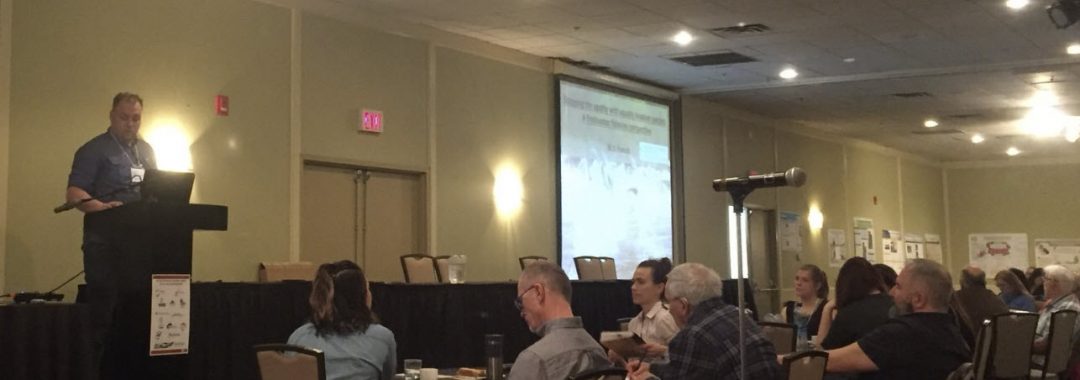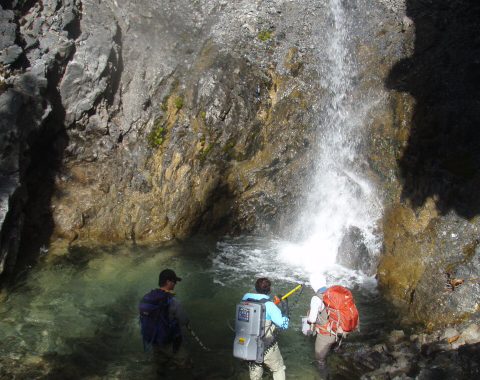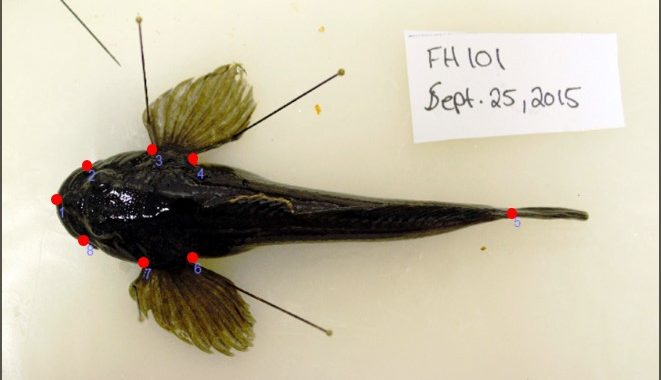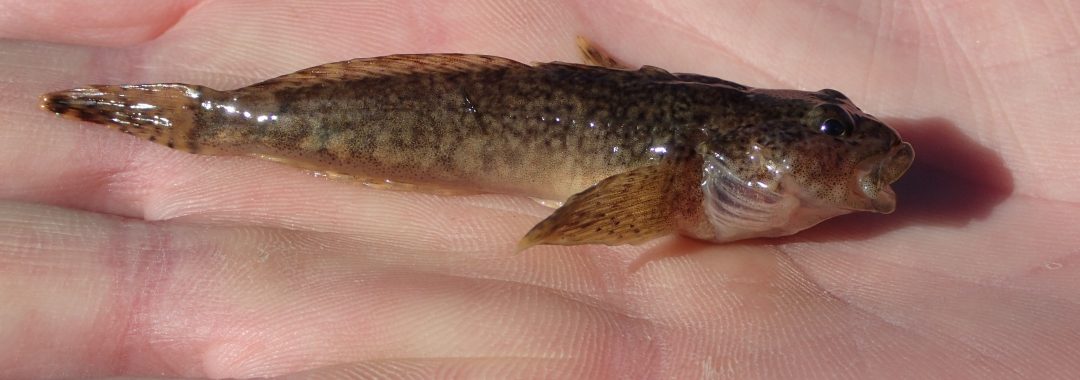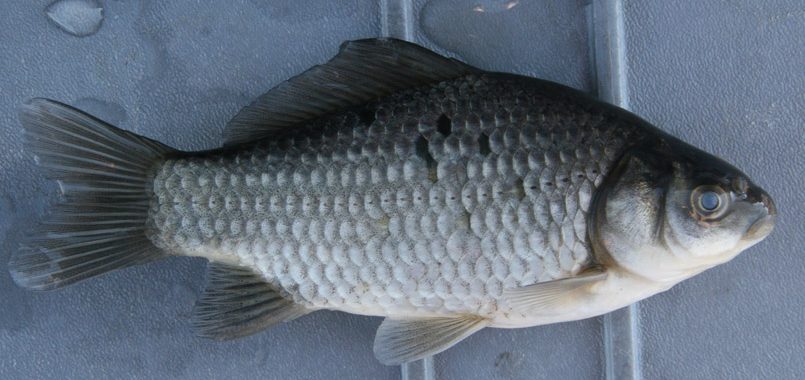It was a great honour to give a plenary talk on freshwater invasive species and participate in a panel discussion with Dr. Daniel Simberloff (University of Tennessee), Dr. Chris Thomas (University of York, UK), Jason Fisher and Margo Pybus at this year’s Alberta Wildlife Society meeting in Lethbridge. I really enjoyed the discussion on invasive species! I was also very impressed to see as many as five undergraduate students from my Fish and Wildlife class in attendance! Also happy to see my students Sebastian Theis (PhD candidate), Jesse Shirton (undergraduate) and Jamie Card (undergraduate) present posters on their research!
Category Archives: Conservation of Freshwater Fishes
Freshwater fishes are among the most imperiled groups globally with rates of decline comparable to declines in tropical rainforest species. Research in the PoeschLab focuses on developing a better understanding of the mechanisms for the decline of freshwater organisms. This research has four main themes, including: 1) threats to freshwater species at risk, 2) stream augmentation and hydrologic alteration, 3) climate change impacts to freshwater fishes, and 4) the spread and impact of invasive species. To achieve our research goals we utilize a variety of expertise in the PoeschLab and the University of Alberta. This includes expertise in: movement ecology and telemetry, assessing foodwebs using stable isotope analysis, population genetics and environmental DNA (eDNA) and morphology and swim performance.
Neufeld, K.*, Watkinson, D., Tierney, K. and M.S. Poesch. (2018) Incorporating connectivity in measures of habitat suitability to assess impacts of hydrologic alteration to stream fish. Diversity and Distributions 24: 593-604.
Abstract
Hydrologic alterations are widespread in freshwater ecosystems worldwide and often detrimentally impact fish populations. Habitat suitability models are commonly used to assess these impacts, but these models frequently rely upon observed fish–habitat relationships rather than more mechanistic underpinnings. The aim of this study was to demonstrate how to incorporate swim performance into a measure of habitat connectivity at a fine scale, providing a method for assessing the availability of suitable habitat for stream fishes. We applied this technique to an endangered species, the Western Silvery Minnow Hybognathus argyritis, in the Milk River of southern Alberta, Canada. The Milk River is an augmented system, where a diversion in nearby St. Mary River augments flow by a factor >3 × (from 1–5 m3/s to 15–20 m3/s). We used laboratory measured swim performance of Western Silvery Minnow to develop a movement cost function that was used in conjunction with a habitat suitability model to assess habitat availability via a recently developed graph-theoretic metric, equivalent connected area (ECA). Stream augmentation altered not only habitat suitability but also habitat connectivity for this species. During augmentation, suitable habitat area declined by 81.3%. Changes in habitat connectivity were site dependent. Movement costs between habitat patches were lower during augmentation due to current-assisted dispersal and increased distance to patches during natural flows from dried streambeds. When movement costs were incorporated into ECA, ECA decreased by 78.0% during augmentation.With changing climate and increasing anthropogenic impacts on aquatic ecosystems, understanding how freshwater fishes relate to their habitat is critical for appropriate management. In many cases, such as the Western Silvery Minnow, mitigating habitat suitability may not be sufficient, as species are unable to reach suitable habitat. The incorporation of swim performance into habitat connectivity assessments, as carried out here, can be easily adapted to other species and situations and can improve the understanding of impacts to stream fishes and increase the effectiveness of mitigation efforts.
Citation: Neufeld, K.*, Watkinson, D., Tierney, K. and M.S. Poesch. (2018) Incorporating connectivity in measures of habitat suitability to assess impacts of hydrologic alteration to stream fish. Diversity and Distributions 24: 593-604.
Movement Cost of Western Silvery Minnow under Augment (top) and Natural (bottom) Flow Conditions
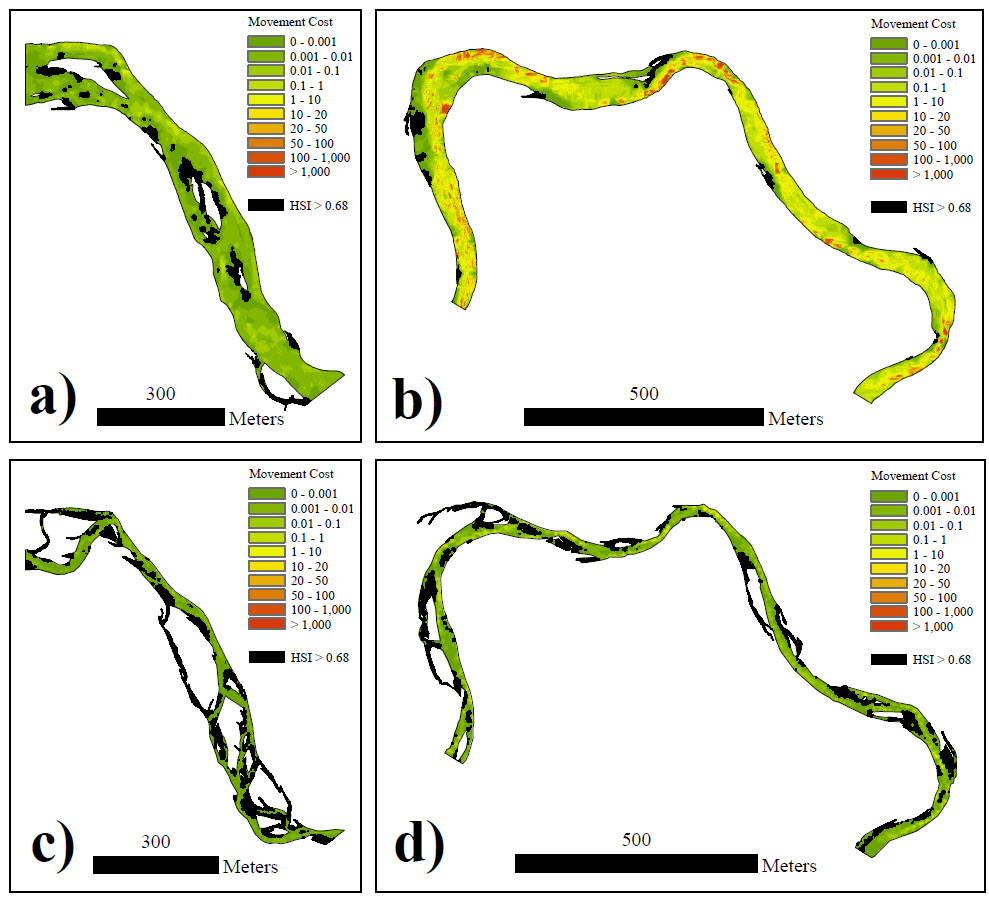
Also Read:
*Lab members: Kenton Neufeld, Mark Poesch. Check out opportunities in the lab!
Rudolfsen, T.*, Watkinson, D. and Poesch, M.S. (2018) Morphological divergence of the Threatened Rocky Mountain sculpin (Cottus sp.) is driven by biogeography and flow regime. Aquatic Conservation: Marine and Freshwater Ecosystems 28: 78-86.
Abstract
Stream hydrology is considered the primary factor in structuring freshwater fish communities,influencing stream habitats, food resources, and life‐history characteristics. Changes in stream hydrology, from climate change and anthropogenic sources (e.g. dams, irrigation channels), are thought to have adverse impacts on many freshwater species. The Rocky Mountain Sculpin (Cottus sp.) is a threatened species in Canada. Phenotypes of Rocky Mountain Sculpin were compared across a gradient of four streams differing in stream hydrology. It was hypothesized that Rocky Mountain Sculpin would show body forms minimizing drag in higher flow environments. Using geometric morphometrics and meristic counts, body shape, fin rays, and sensory pores were compared. As hypothesized, high‐flow river systems were correlated with sculpin with more dorso‐ventrally compressed, slender body shapes that minimized resistance to flow (P<0.001). Rocky Mountain Sculpin had more pectoral fin rays in populations with higher flows than lower flows,potentially allowing them to increase friction when gripping onto the substrate (P<0.001), and more anteriorly and dorsally located head pores to improve detection of floating prey (P<0.001). Biogeographic isolation and difference in flow regime were the likely basis for the observed morphological variation. The degree to which these phenotypes become fixed is unknown;however, since phenotypic diversity parallels genetic diversity in Rocky Mountain Sculpin,there is the possibility that persistent selection of these phenotypes can make it difficult to adapt to rapidly changing habitat conditions, such as changing flow. This study emphasizes the importance of considering phenotypic and morphological variation when evaluating how best to mitigate anthropogenic stressors and their impact on freshwater fishes.
Citation: Rudolfsen, T.*, Watkinson, D. and Poesch, M.S. (2018) Morphological divergence of the Threatened Rocky Mountain sculpin (Cottus sp.) is driven by biogeography and flow regime. Aquatic Conservation: Marine and Freshwater Ecosystems 28: 78-86.
Flow Regime across the range of Rocky Mountain Sculpin
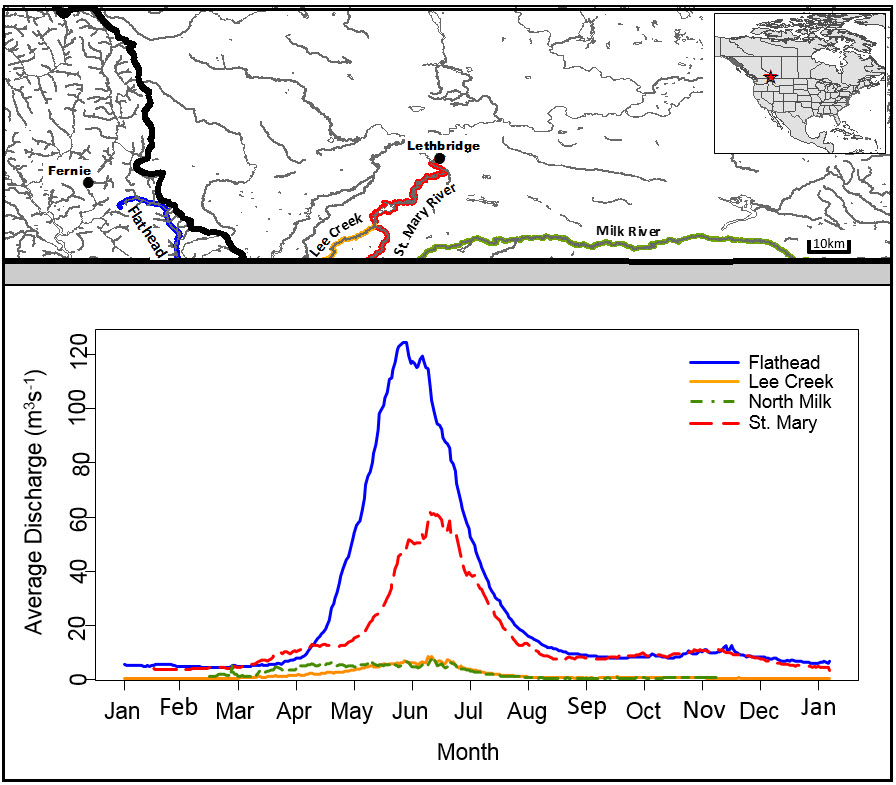
Morphological Differences Across Populations (Dorsal view) of Rocky Mountain Sculpin
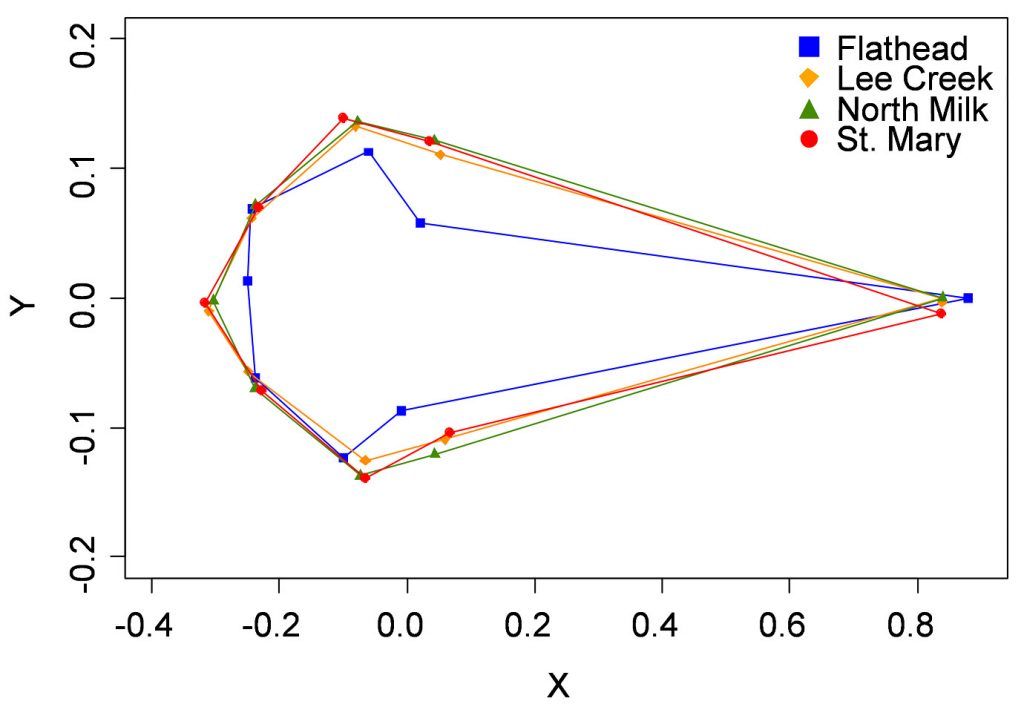
Also Read:
* Lab members: Tyana Rudolfsen, Mark Poesch. Check out opportunities in the lab!
Rudolfsen, T.A. (2017) Characterizing adaptive morphological features and resource selection of Rocky Mountain Sculpin (Cottus sp.), a species at risk in Canada
Thesis Title: Characterizing adaptive morphological features and resource selection of Rocky Mountain Sculpin (Cottus sp.), a species at risk in Canada
Author: Tyana Rudolfsen
Abstract
Freshwater biodiversity is presently one of the world’s largest conservation concerns. Both direct and indirect human activities contributing to waterway modifications, climate change, and habitat alteration are causing major declines in freshwater fish species richness and abundance. While these impacts are well studied for pelagic fishes, little is known about how to best direct management efforts toward benthic, dispersal-limited fishes. The Rocky Mountain Sculpin (Cottus sp.), a benthic, sedentary, and federally listed species at risk in Canada, was used to address the following objectives: 1) to identify its susceptibility to varying flow regime, and whether or not it displays morphological adaptation to flow, and 2) to characterize hybrid zones and the driving environmental factors that lead to their persistence. Using geometric morphometrics and meristic counts of fin rays/spines and sensory pores, phenotype was compared across the four river populations in Canada. Systems with higher flow regimes generally had Rocky Mountain Sculpin that were more dorso-ventrally compressed and had meristic features better suited to positioning themselves among cobble substrate and detecting prey in fast moving water. Biogeographic isolation contributed to phenotypic variation, indicating that the Rocky Mountain Sculpin might not be able to quickly adapt to human-induced flow alterations. To achieve the second objective, hybrid zones between the westslope Rocky Mountain Sculpin population (Flathead River drainage, BC) and the Slimy Sculpin (Cottus cognatus) were studied. Using 731 genetic samples and 10 polymorphic microsatellite loci, two hybrid zones were identified more upstream than expected from previous studies. A logistic mixed-effects model revealed that habitat features relating to climate change and water quality were driving an upstream range expansion of Rocky Mountain Sculpin and movement of hybrid zones. While the Rocky Mountain Sculpin, despite their sedentary life history, appears to have more tolerance to anthropogenic habitat alterations that originally expected, their tolerance level likely has limits that can be widely detrimental to the species if tested. Further, given their high levels of phenotypic variation across populations, management efforts involving dispersal-limited species should be directed at the population level. In the event of hybrid zones, which are indicators of more localized environmental factors driving species presence, a more localized scale of management might be required.
Docherty, C. (2017) Establishment, spread and impact of Prussian Carp (Carassius gibelio), a new invasive species in Western North America.
Thesis Title: Establishment, spread and impact of Prussian Carp (Carassius gibelio), a new invasive species in Western North America.
Author: Cassandra Docherty
Abstract
Freshwater ecosystems are some of the most imperilled on the planet. Invasive species pose the second largest threat to freshwater organisms after habitat degradation. Aquatic introductions have led to extinctions, competition for resources, hybridization, the introduction of foreign pathogens and the alteration of ecosystem structure and function. One of the most recent invaders in western North America is Prussian Carp (Carassius gibelio). The first record of this species in North America was in 2000, in Alberta, Canada, yet little is known about its invasion, current distribution or effects on stream communities. In Eurasia, Prussian Carp have been assessed as one of the most harmful invasive fish species because of its ability to reproduce asexually, high environmental tolerances and preference for human modified habitats. The arrival of Prussian Carp in western North America poses concerns for many native freshwater species. Therefore, the objectives of this study were to assess the severity of Prussian Carp’s invasion in western North America by 1) mapping Prussian Carp distribution and rate of spread since its initial arrival; 2) analysing the impact of Prussian Carp on native fish species; and 3) identifying environmental parameters that predict Prussian Carp presence. Using kernel density functions, we found that the range of Prussian Carp increased in Alberta, Canada from approximately 500 km² since its arrival (estimated as 2000) to over 20,000 km² in 2014. The rate of spread is increasing at an exponential rate over five year increments (e.g. 1.6, 2.1, and 2.3 times), suggesting rapid expansion since first detection. Our results did not indicate that Prussian Carp have a negative effect on native fish species, which is likely due to its recent expansion into these areas and an already depauperate species community. The most important habitat variables that best predicted the presence of Prussian Carp were: dense aquatic vegetation, high conductivity, pH, high dissolved oxygen and low flow rates indicating preference for relatively slow, eutrophic streams. Successful management of this species in western North America will require the integration of all levels of government between neighbouring provincial and national borders, as well as the public. Prussian Carp are a highly mobile species and given the connection to other watersheds in Canada and proximity to the Missouri/Mississippi drainages in the United States, agencies throughout North America should be aware of this invasive species and the potential impacts on native biota
Neufeld, K., Watkinson, D, and M.S. Poesch. 2017. COSEWIC status report on the Western Silvery Minnow (Hybognathus argyritis). Ottawa, Ontario, pp 46.
Citation: Neufeld, K., Watkinson, D, and M.S. Poesch. 2017. COSEWIC status report on the Western Silvery Minnow (Hybognathus argyritis). Ottawa, Ontario, pp 46.
Note: once published, copyright is owned by COSEWIC.
Ruppert, J.L.W.*, Docherty,C.*, Rudolfsen, T.*, Neufeld, K.*, Hamilton, K.*, MacPherson, L. and M.S. Poesch. (2017) Native North American freshwater species get out of the way: Prussian Carp (Carassius gibelio) establishment impacts both fish and macroinvertebrate communities. Royal Society Open Science 4: 170400.
Abstract:
Prussian carp (Carassius gibelio) are one of the most noxious non-native species in Eurasia. Recently, Prussian carp, a nonnative freshwater fish species, were genetically confirmed in Alberta, Canada and have been rapidly expanding their range in North America since establishment. Given their rapid range expansion, there is an increasing need to determine how Prussian carp may impact native species. We assessed the severity of the Prussian carp invasion by (i) determining their impact on fish communities, (ii) assessing their impact on benthic invertebrate communities, (iii) evaluating if Prussian carp alter abiotic conditions, and (iv) identifying where we find higher abundances of Prussian carp. When Prussian carp were established, we found significant changes to the fish community. Correspondingly, the degree of impact to benthic invertebrate communities was related to the stage of invasion (none, early or recent), where changes in fish communities were significantly concordant with changes in benthic invertebrate communities. Finally, we found that higher abundances of Prussian carp were significantly associated with lower abundances of a majority of native fish species. Altogether, using three lines of evidence, we determine that Prussian carp can have wide-ranging impacts on freshwater ecosystems in North America, pressing the need for management intervention.
Citation: Ruppert, J.L.W.*, Docherty,C.*, Rudolfsen, T.*, Neufeld, K.*, Hamilton, K.*, MacPherson, L. and M.S. Poesch. (2017) Native North American freshwater species get out of the way: Prussian Carp (Carassius gibelio) establishment impacts both fish and macroinvertebrate communities. Royal Society Open Science 4: 170400.
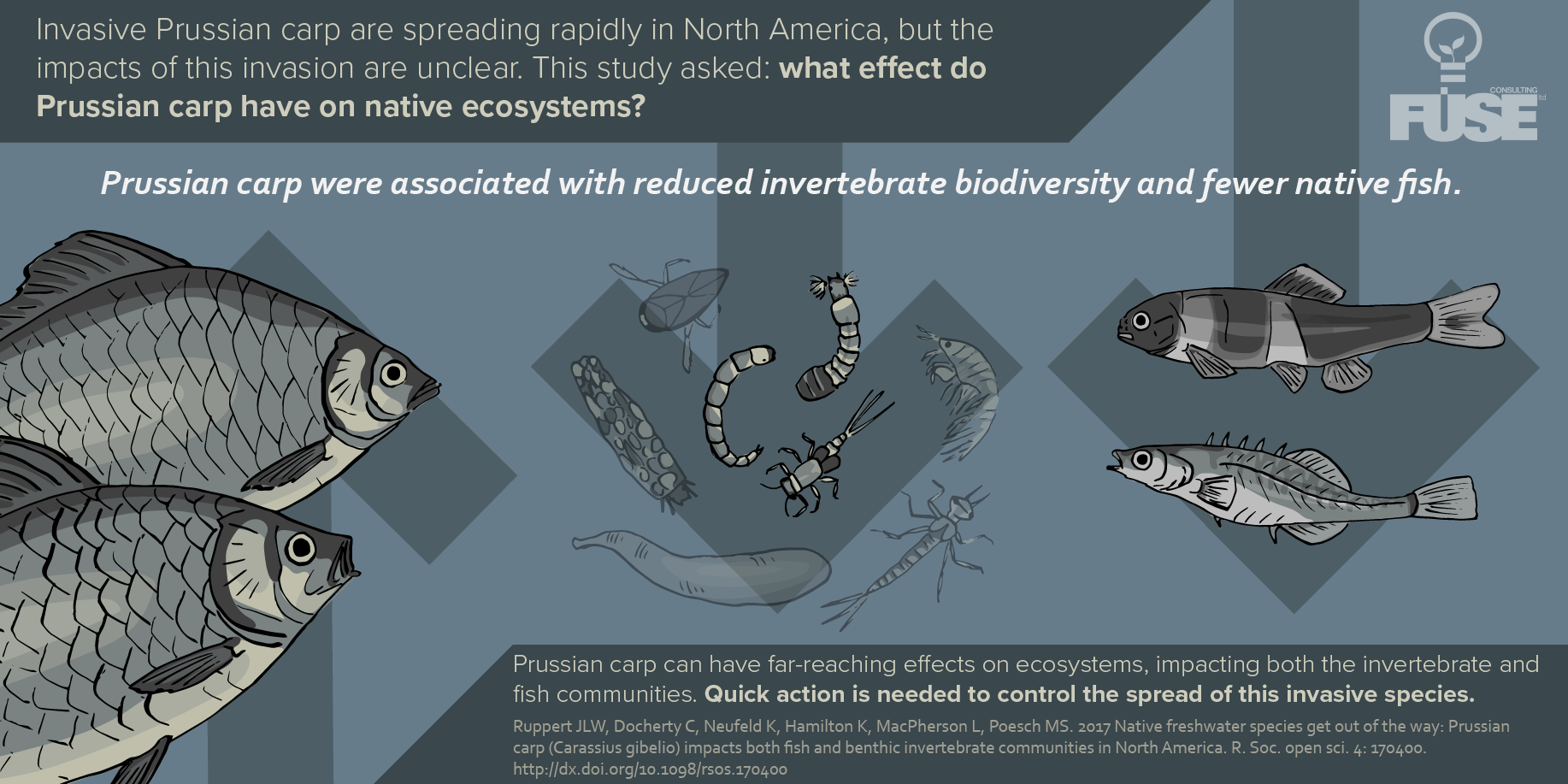
Also Read:
*Lab members: Jonathan Ruppert, Cassandra Docherty, Tyana Rudolfsen, Kenton Neufeld, Kyle Hamilton, Mark Poesch. Check out opportunities in the lab!
Docherty, C.*, Ruppert, J.*, Rudolfsen, T.*, Hamann, A., and Poesch, M.S. (2017) Assessing the spread and potential impact of Prussian Carp (Carassius gibelio Bloch, 1782) to freshwater fishes in western North America. BioInvasions Records 6: 291-296.
Abstract:
Prussian Carp (Carassius gibelio Bloch, 1782) is one of the most successful invasive species in Eurasia. Recently, Prussian Carp were genetically confirmed in Alberta, Canada, documenting the first detection of this species in North America. Given the close morphological similarity to their sister species, the Goldfish (Carassius auratus Linnaeus, 1758), it is likely that this species has been undetected for some time. We document the spread of Prussian Carp since arrival (circa 2000), and contribute a trait-based risk assessment to potential recipient communities in western North America. Using a meta-analysis of geo-referenced fisheries data in conjunction with original sampling in 2014, we show that the Prussian Carp range has increased by eight- to eleven-fold over 15 years in Alberta at a rate of approximately 233–1,250 km2 per year. Range expansions in the near future are possible through the Saskatchewan River drainage and south into the Missouri River basin, with easily accessible routes to Midwestern North America through irrigation canals. We show high life history trait overlap with other successful invasive species, such as Goldfish and Common Carp (Cyprinus carpio Linnaeus, 1758). Additionally, there was high life history trait overlap with several species of native sunfish (Centrarchidae) and suckers (Catostomidae). This study highlights Prussian Carp’s potential to widely impact North American freshwater ecosystems and to successfully compete with native taxa. Considered one of the worst invaders in Eurasia, the arrival of Prussian Carp in North America poses serious concern for fisheries managers. There is an urgent need to develop management plans before further range expansion and disruption of freshwater ecosystems by this new invasive species.
Citation: Docherty, C.*, Ruppert, J.*, Rudolfsen, T.*, Hamann, A., and Poesch, M.S. 2017. Assessing the spread and potential impact of Prussian Carp (Carassius gibelio Bloch, 1782) to freshwater fishes in western North America. BioInvasions Records 6: 291-296.
Spread of Prussian Carp in Alberta, Canada
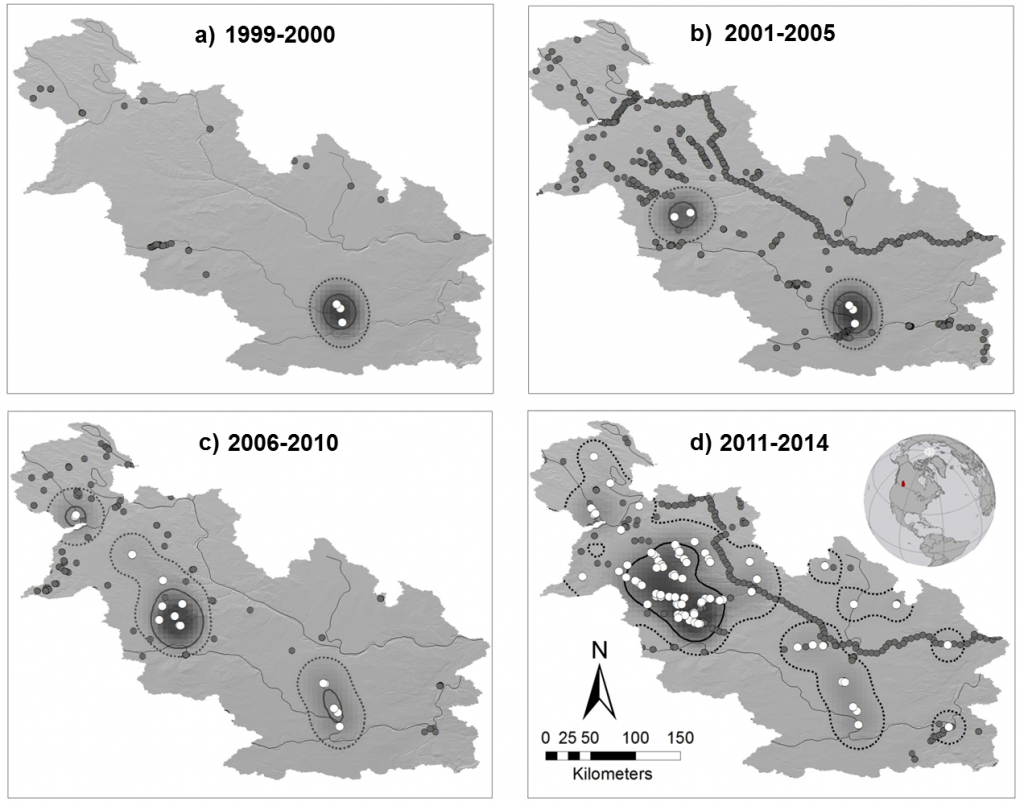
Also Read:
*Lab members: Cassandra Docherty, Jonathan Ruppert, Tyana Rudolfsen, Mark Poesch. Check out opportunities in the lab!

